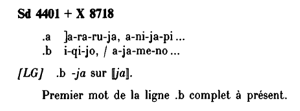CLASS X
After Evans’s discovery of the first Mycenaean tablets from Knossos in 1900, the study of Linear B texts remained severely limited for a long time, due to the absence of an ordered classification of the emerging documents and the constitutive elements of the Mycenaean signary: syllabograms and logograms.
The discovery of the Linear B archive at Pylos, in Messenia, in 1939, increased the number of available texts. These were studied by Emmett L. Bennett Jr., who in 1950-51 completed a systematic catalogue of the available evidence, by grouping the texts according to the simplest and most intuitive tool at hand – the same as that used by the scribes themselves – “logograms” (Bennett, 1950-51).
It is worth remembering that logograms, that is to say sematographic signs of iconic or conventional / non-iconic shape, were used to represent, for example, men, animals, commodities and agricultural products – in this website, the term “logogram”, is conventionally used to refer to the sematographic apparatus of the script, as opposed to phonetic notations in extenso.
The Linear B documents have thus been classified by means of an alpha-numerical system, where the letters may refer to a specific logogram or group of logograms. On the basis of this convention, the class identified by the initial A- is related to the logogram for man; class D- to the logogram for sheep etc. The series X includes conventionally all the documents which cannot be assigned to specific categories, due to their fragmentary state or the absence of logograms.
Over the years, many epigraphic, palaeographical and philological studies have focused on the fragments included in this latter class: their purpose was to provide revisions and possibly integrations to the available documentation. In this way, research has led to the identification of several fragments which had originally belonged to the same tablets, and these have been integrated through joins.
Joins may carry various degrees of precision. When a perfect correspondence is identified, a ‘+’ is indicated between the numbers of the fragments; a ‘[+]’ indicates instead that the match is imperfect, although there are enough clues as to suggest that two (or more) fragments belong to the same tablet.
Let us consider, for example, Sd 4401 and L 515. The former may perfectly be jointed to fragment X 8718, therefore we indicate these as follows: Sd 4410 + X 8718. Although a conjunction is very likely, the latter, is indicated, instead, as L 515 [+] X 7611, due to the lack of a perfect correspondence with fragment X 7611.


X 522 X 697 X 6029 X 7546 X 7554 X 7629 X 7749 X 8502 X 9020
X 9196 X 9209 X 9375 X 9721 Xd 107 Xd 149 Xd 149 verso Xd 7914 Xf 5104
Data License. The 2D+ and 3D-models of artifacts presented in the database of paitoproject are for scientific, non-profit use of scientists. All 2D+ and 3D-models are subject to copyright laws with all rights reserved.
Reproduction, publication or commercial use of these 2D+3D-datasets is strictly prohibited without prior written permission. For further information, contact: Prof Alessandro Greco a.greco@uniroma1.it






















